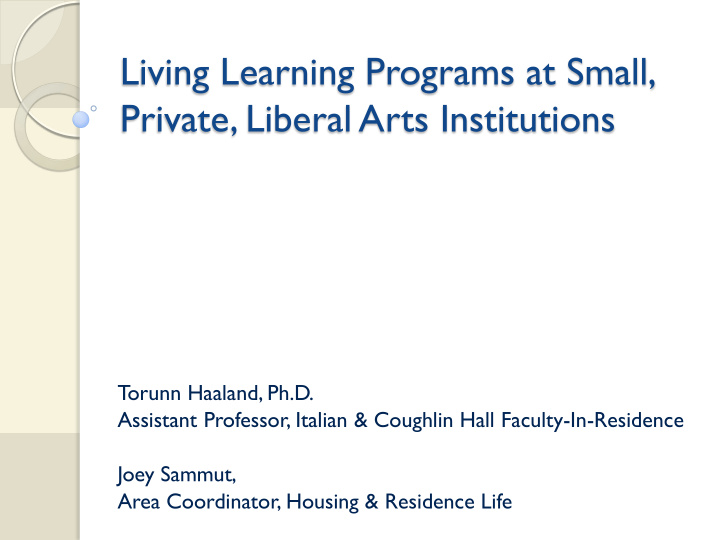



Living Learning Programs at Small, Private, Liberal Arts Institutions Torunn Haaland, Ph.D. Assistant Professor, Italian & Coughlin Hall Faculty-In-Residence Joey Sammut, Area Coordinator, Housing & Residence Life
Gonzaga University at a Glance Private, Catholic, Jesuit institution in Spokane, WA 2 year residency requirement 3000 beds on campus (4800 undergrad total) 6 Living-Learning Communities (500 students) ◦ Learns 2 Lead ◦ Women for Others ◦ Cura Personalis ◦ Encountering Cultures ◦ KEEN ◦ Outdoor Pursuits
Why This Roundtable?
What the Research Says Learning communities do more than co- register students around a topic or theme; they change the manner in which students experience the curriculum and the way they are taught (Tinto, 2000). Liberal arts colleges provide an in-class academic experience with faculty that is based on challenge and interaction more so than research universities and regional institutions (Seifert, Pascarella, et al, 2010).
What the Research Says Learning communities can enhance student satisfaction with the residential living and learning experience, but lack of faculty and residential staff planning and accountability can significantly reduce the benefits of the learning community […] communities with more interactions had higher levels of student satisfaction with the community experience (Eighmy & Frazier, 2012).
What the Research Says The advantages in exposure to good practices fostered by liberal arts colleges may be more likely to accrue to subgroups of students, particularly those who enter postsecondary education with lower levels of parental education, tested precollege academic preparation, academic motivation, and high school involvement. These compensatory effects served as an advantage for students at liberal arts colleges who entered college with lower than average levels on these background and precollege characteristics compared with their peers at research universities, regional institutions, and community colleges (Seifert & Pascarella, 2010).
What the Research Says Programs effective in facilitating student learning outcomes can be: (a) large or small; (b) well or modestly resourced; or (c) a strong partnership between academic and student affairs or primarily residential life focused […] programs with larger enrollments but only moderate resources with loosely coupled academic and student affairs partnerships may be the least effective (Inkelas et al, 2008). Besides “encouraging students to connect ideas from different disciplines, “ LLPs also help “linking of students through ongoing social interactions afforded by being with the same students for an extended period of time. As a result, students become members of a community focused on academic content, which allows them to further develop their identify and discover their voice as well as to integrate what they are learning into their worldview and other academic and social experiences (Zhao & Kuh, 2004).
What the Research Says Participating in learning communities is uniformly and positive linked with student academic performance, engagement in educationally fruitful activities (such as academic integration, active and collaborative learning, and interaction with faculty members), gains associated with college attendance, and overall satisfaction with the college experience (Zhao & Kuh, 2004). Persistence and grades are higher for first-year students from learning communities that provide a strong sense of community, in which instructors are engaged and approachable, and where a strong and visible linkage exists between instructors, subject matter, and course organization (Lichtenstein, 2005).
Roundtable What are the unique advantages/challenges you find at your institutional type? What differences are there in terms of formative principles/structures and student experiences with LLPs at your institution? What do and what could LLPs at LACs do ◦ beyond operating proactively (rather than reactively) to reinforce students’ exposure to best practices of undergraduate education? ◦ to reinforce critical dimensions of the learning environment such as diversity and interaction with peers and faculty? ◦ to support the experiences of less prepared, less guided and apparently less motivated students? What are ways we can facilitate student’s continued development of knowledge acquisition? What could LLPs at LACs do to serve, support, and reinforce interaction, planning and accountability among faculty and staff? How does planning/accountability look similar/different? What are the unique advantages and disadvantages? What have you learned at this conference that can be integrated into your viewpoint? How can we interpret research in a way that still applies to our institutional type?
Works Cited Eighmy, M., & Frazier, W. (2012). Themed residential learning communities: The importance of purposeful faculty and staff involvement and student engagement. Journal of College & University Student Housing, 38 (2). Inkelas, K. K. et al. (2008). Differences in student outcomes by types of living – learning programs: The development of an empirical typology.” Research in Higher Education 49 . Lichtenstein, M. (2005). The importance of classroom environments in the assessment of learning community outcomes.” Journal of College Student Development, 46 (4), pp. 341- 356. Seifert, T. A., Pascarella, E.T., et al. (2010). Liberal arts colleges and good practices in undergraduate education: Additional evidence. Journal of College Student Development, 51 (1). Tinto, V. (2000). What have we learned about the impact of learning communities on students? Assessment Update, 12 (2), 1 – 2, 12. Zhao, C, & Kuh, G. D. (2004). Adding value: Learning communities and student engagement. Research in Higher Education, 45 (2).
Thank You! T orunn Haaland - haaland@gonzaga.edu Joey Sammut - sammut@gonzaga.edu
Recommend
More recommend